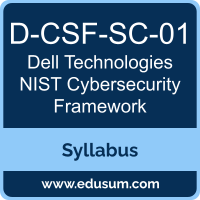 Use this quick start guide to collect all the information about Dell Technologies NIST Cybersecurity Framework (D-CSF-SC-01) Certification exam. This study guide provides a list of objectives and resources that will help you prepare for items on the D-CSF-SC-01 Dell Technologies NIST Cybersecurity Framework 2.0 exam. The Sample Questions will help you identify the type and difficulty level of the questions and the Practice Exams will make you familiar with the format and environment of an exam. You should refer this guide carefully before attempting your actual Dell Technologies NIST Cybersecurity Framework certification exam.
Use this quick start guide to collect all the information about Dell Technologies NIST Cybersecurity Framework (D-CSF-SC-01) Certification exam. This study guide provides a list of objectives and resources that will help you prepare for items on the D-CSF-SC-01 Dell Technologies NIST Cybersecurity Framework 2.0 exam. The Sample Questions will help you identify the type and difficulty level of the questions and the Practice Exams will make you familiar with the format and environment of an exam. You should refer this guide carefully before attempting your actual Dell Technologies NIST Cybersecurity Framework certification exam.
The Dell Technologies NIST Cybersecurity Framework certification is mainly targeted to those candidates who want to build their career in Security domain. The Dell Technologies Certified NIST Cybersecurity Framework 2.0 exam verifies that the candidate possesses the fundamental knowledge and proven skills in the area of Dell Technologies NIST Cybersecurity Framework.
Dell Technologies NIST Cybersecurity Framework Exam Summary:
| Exam Name | Dell Technologies Certified NIST Cybersecurity Framework 2.0 |
| Exam Code | D-CSF-SC-01 |
| Exam Price | $230 (USD) |
| Duration | 90 mins |
| Number of Questions | 60 |
| Passing Score | 63% |
| Books / Training | NIST Cybersecurity Framework 2.0 Training |
| Schedule Exam | Pearson VUE |
| Sample Questions | Dell Technologies NIST Cybersecurity Framework Sample Questions |
| Practice Exam | Dell Technologies D-CSF-SC-01 Certification Practice Exam |
Dell Technologies D-CSF-SC-01 Exam Syllabus Topics:
| Topic | Details | Weights |
|---|---|---|
| NIST CSF 2.0 Introduction |
- Identify the increasing data security threats to IT systems and data. - Define the reasons why an effective cybersecurity stance is important. - Explain the purpose and the key changes of the NIST CSF 2.0 framework. - Describe the NIST CSF 2.0 components. - Identify the six NIST CSF 2.0 Core Functions. |
8% |
| NIST Framework: GOVERN Function |
- Describe GOVERN Function and its relationship with the Enterprise Risk Management (ERM). - Explain GOVERN Function categories and subcategories. - Define the organizational context and risk management strategy. - Establish clear policies and procedures to guide cybersecurity activities. - Define clear roles and responsibilities for cybersecurity personnel. - Identify and manage cybersecurity risks associated with suppliers and third-party vendors. |
18% |
| NIST Framework: IDENTITY Function |
- Explain IDENTITY Function with its categories and subcategories. - Identify and inventory all assets and categorize them based on their criticality and sensitivity. - Assign ownership and responsibility for each asset. - List the tools and techniques used in asset management. - Describe risk assessment. - Describe the controls and techniques in the Incident Response Life Cycle, Contingency Plan, and Business Continuity Plan. |
18% |
| NIST Framework: PROTECT Function |
- Explain the PROTECT Function, its categories, and subcategories. - Learn about the processes and controls involved in identity management, authentication, and access control. - Understand the need for awareness and training. - Learn about the processes and controls involved in data and platform security. - Understand the processes and controls involved in technology infrastructure resilience. |
12% |
| NIST Framework: DETECT Function |
- Explain the categories and subcategories of the DETECT Function. - Describe the significance of continuous monitoring and associated security controls in the DETECT Function. - Describe the significance of adverse event analysis and associated security controls in DETECT Function. - Elaborate the tools and techniques that can be employed for achieving continuous monitoring and adverse event analysis. |
7% |
| NIST Framework: RESPOND Function |
- Understand the basic concepts and categories of the RESPOND Function. - Learn about the processes involved in managing incidents. - Gain knowledge on analyzing incidents with a focus on controls. - Comprehend the reporting and communication aspects of incident response. - Understand the strategies and techniques to minimize the impact of an incident. |
8% |
| NIST Framework: RECOVER Function |
- Explain the categories and subcategories of the RECOVER Function. - Analyze the significance of incident recovery plan execution and associated security controls in the RECOVER Function. - Explain the significance of incident recovery communication and associated security controls in the RECOVER Function. - Elaborate the tools and techniques that can be employed for incident recovery plan execution. |
7% |
| Analyze NIST CSF Profiles |
- Understand the concept of NIST CSF Organizational Profiles. - Explore different Organizational Profiles. - Discover how to develop and apply Organizational Profiles. - Understand the application of NIST CSF Profiles in practical scenarios. |
7% |
| Applying NIST CSF Tiers |
- Grasp core concepts and structure of Cybersecurity Framework (CSF) tiers. - Choose appropriate tiers for risk governance and management. - Apply the NIST CSF tiers in practical scenarios. |
5% |
| Assess Cybersecurity Risk Communication and Integration |
- Explain cybersecurity risks and their impact on organizations. - Utilize effective communication strategies to convey cybersecurity risks. - Integrate cybersecurity risk management into broader enterprise risk management programs. - Explain the importance of Supply Chain Risk Management (SCRM) in cybersecurity. - Identify and manage the risks associated with emerging technologies, such as AI. - Describe AI risk management frameworks, tools, and techniques. |
10% |
To ensure success in Dell Technologies NIST Cybersecurity Framework certification exam, we recommend authorized training course, practice test and hands-on experience to prepare for Dell Technologies NIST Cybersecurity Framework 2.0 (D-CSF-SC-01) exam.
